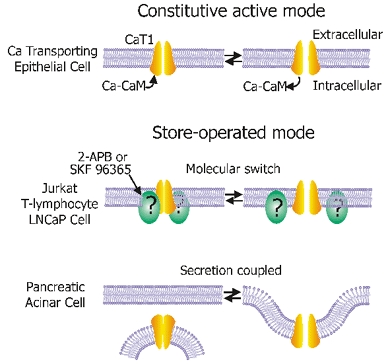Figure 3. Modes of CaT1 activation.

Constitutive active mode: CaT1 alone is constitutively active and works in this mode in Ca2+-transporting epithelia such as the brush-border membrane of small intestine. The channels are subject to Ca2+-dependent feedback regulation and this process is partially mediated by calmodulin (CaM). Store-operated mode: CaT1 is not active in unstimulated cells and is activated by calcium store depletion. Two putative mechanisms are shown. Molecular switch mode: another cellular component serves as a molecular switch to shut CaT1 off when it is associated with CaT1 or to activate CaT1 upon its dissociation. This component might be the target of 2-APB or SKF 96365, which may promote the association state, as suggested by studies in Jurkat T-lymphocytes or LNCaP cells. Secretion-coupled mode: inactivated CaT1 may localize in the membrane of intracellular vesicles. Upon exocytosis, CaT1 is incorporated into plasma membrane. The plasma membrane-associated CaT1 takes up Ca2+ released from the vesicle to refill the calcium store or to trigger further exocytosis.
